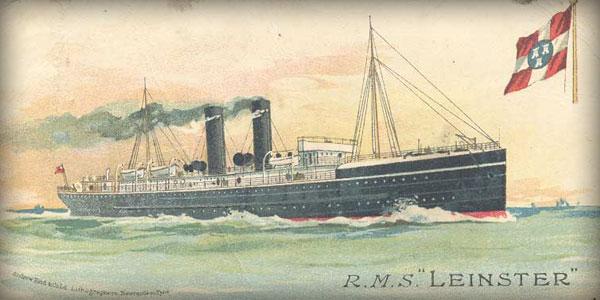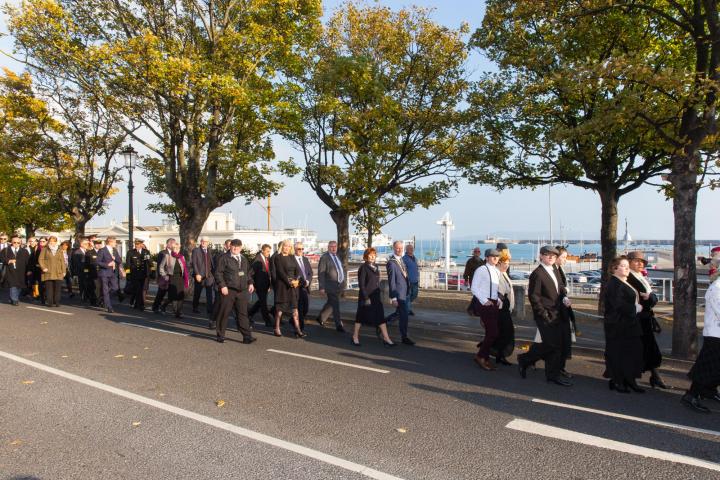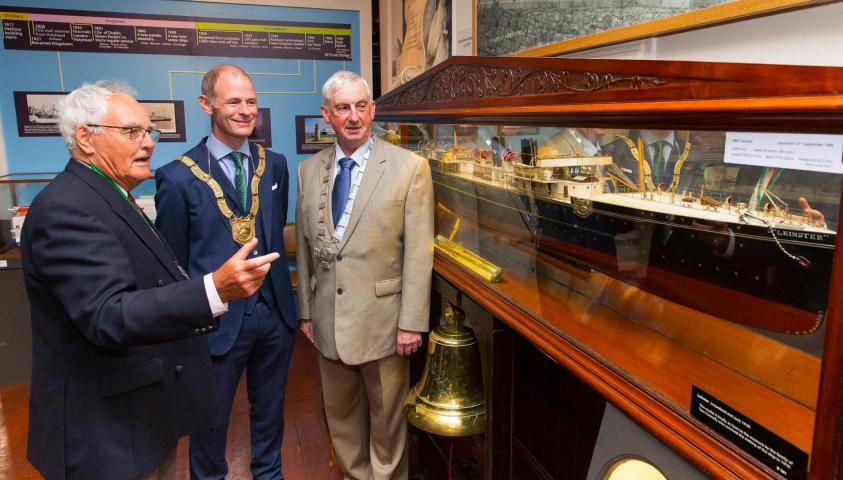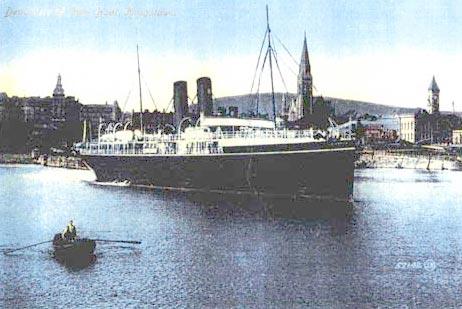In the dying days of World War 1, a German submarine torpedoed the Dún Laoghaire (then Kingstown) to Holyhead mail boat R.M.S. Leinster. 501 people died in the greatest ever loss of life in the Irish Sea. The crew were drawn from the towns of Dún Laoghaire and Holyhead. Twenty-two postal sorters from Dublin Post Office worked on an onboard mail sorting room. The majority of passengers on the ship that day were military personnel, many going on or returning from leave. Among them were many Irish men and women. In October 2003 the 85th anniversary of the sinking will be marked by joint memorial services in Dún Laoghaire and Holyhead. The Dún Laoghaire service will be held on Friday 10 Octover 2003, the date of the 85th anniversary. Details are yet to be finalised. The Holyhead service will be held at St. Cybi’s Church at 14.30 hrs on Sunday 12 October 2003.
City of Dublin Steam Packet Company
The City of Dublin Steam Packet Company (CDSDCo) was founded in dublin 1822 by Charles Wye Williams. Originally called Charles Wye Williams and Co., the name was later changed to the CDSPCo. From 24 January 1839 the Post Office contracted the CDSPco to run a night mail service. The Admiralty were,
Leinster Log Page 2
contracted to operate a day service. On 1 August 1848 the first train to link with the mail packet ran from Euston, London to Holyhead. The Irish Mail was the world’s first named train. From 1 January 1850 the CDSPCo secured the contract to run both the day and night mail service. In 1859, to update their fleet, the company placed orders for the construction of four paddle steamers. They were named after Ireland’s provinces Connaught, Leinster, Munster and Ulster. They used the prefix R.M.S., which stood for Royal Mail Steamer. They operated from the Carlisle Pier at Dún Laoghaire and the Admiralty pier at Holyhead. The CDSPCo workshops were at Salt Island, Holyhead, where engineers carried out repairs to vessels and fabricated replacement parts. The mail ships carried passengers from the early days. Eventually passenger traffic became the company’s main source of revenue.
In 1895 the CDSPCo placed an order with Laird Brothers of Birkenhead for four identical twin-screw steamers. Like their predecessors, the ships were named after the four provinces of Ireland.
On the outbreak of war the Admiralty were legally allowed to take over any British or Irish merchant ships they required. In 1915 they requistioned the Connaught. On 5 May 1915 she left Holyhead for Southampton. For almost two years dhe was used to trasport troops from Southampton to France. On 3 March 1917 she was torpedoed in the English Channel returning from Le Harve. Three of her crew, a Welshman, an Irishman and a Channel Islander, were lost.
In the meantime the CDSPCo operated the Dún Laoghaire to Holyhead route with the three remaining ships. These had a number of close escapes from U-boats. But it seemed as if their luck would hold. Then on Thursday morning 10 October 1918 disaster struck.
Leinster Torpedoed
Leinster left the Carlisle Pier in Dún Laoghaire just before 9 a.m. On board were 77 crew, including Captain William Birch, a Dubliner who lived in Holyhead, twenty-two postal sorters from Dublin’s Post Office, three members of the Royal Navy, to man a twelve pounder gun that had been installed on the back of the ship, 180 civillian passengers and 489 military passengers. The military passengers came from the army, navy and air force. They came from Ireland, Wales, Scotland, England, Canada, United States, New Zealand and Australia. There were also military and volunteer nurses among the crew.
Shortly before 10 a.m. the German submarine UB-123 fired a torpedo at the Leinster. It missed the ship passing across the bow. A secxond torpedo struck the ship on the port side in the vicinity of the ship’s mail room. Only one of the postal sorters survived the sinking. On orders from Captain Birch the ship turned in an attempt to return to Dún Laoghaire. Shortley afterwards a final torpedo struck the Leinster on the starboard side practically blowing it to pieces.
Leinster Log Page 3
The survivors then faced a terrib;e struggle in the rough sea before rescue ships arrived. It was a struggle that many of them lost. The final toll was 501. It was the greatest loss of life in the Irish Sea. It was also one of the worst tradgedies ever to befall Dún Laoghaire and Holyhead.
Dún Laoghaire casualties from Leinster’s crew:
William Brennan, Seaman. Husband of Anne, 135 Lower Georges St.
Thomas Coady, Fireman. Husband of Mary, 13 Clarinda Park North.
Michael Harvey (24), Fireman. Son of Cornelius and Julia, 30 Tivoli Terrace East.
James Hickey (28), Greaser. Husband of Alice, 29 Tivoli Terrace East. His next door neighbour Michael Harvey was also a casualty.
Arthur Jeffries (27), Wireless Operator. Husband of Margaret and step-father to Charlie, Monastir Lodge, Glenageary.
Frank Kehoe (25), Seaman, Son of John and Catherine, 2 Eden Terrace
Henry Longmore (32), Seaman. Husband of Mary, 50 Convent Road.
John Loughlin (45), Able Seaman, Husband of Mary, 105 Patrick Street.
Bernard Murphy (23), Fireman. Son of Bernard and Margaret, 1 Adelaide Cottages.
Patrick O’Toole (22), Fireman. Son of James and Catherine, 1 Summerhill Avenue.
John William Smith (49) Greaser. Husband of Mary, 17 Desmond Avenue.
May they rest in peace.
First Wren to die on active service.
The Women’s Royal Naval Service, known as the Wrens, was first established in 1917. Nineteen year old Josephine Carr was one of the three Wrens from Cork who were travelling together on the R.M.S. Leinster. On 10 October 1918 Josephine became the first Wren to die on active service when she was lost on the Leinster. Her body was never recovered.
Leinster Log Page 4
Photo shows Leinster’s Assistant Purser Bill Sweeney (tall man on the left) with, it is believed, Leinster’s Purser Hugh Rowlands. Dubliner Sweeney survived the sinking and lived until 1979. Holyhead resident Hugh Rowlands was a teacher at Park School Holyhead, before leaving to follow the call of the sea. He was lost on the Leinster.
Anchor recovered.
One of the leinster’s anchors was recovered from the sea in the early 1990’s. In January 1995 it was placed on the seafront in Dún Laoghaire. It is located in front of the Carlisle Pier, from where Leinster set out on her final voyage.








